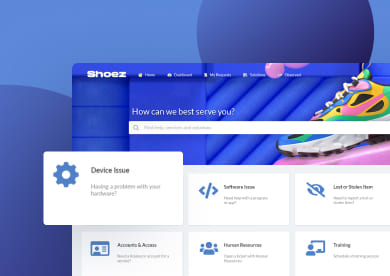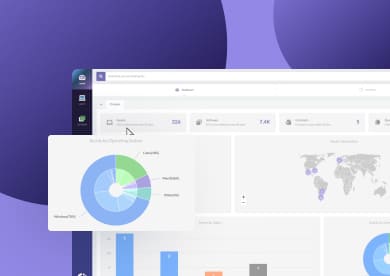IT asset tagging is the practice of labeling IT assets with unique identifiers to track and manage them throughout their lifecycle. In IT Asset Management (ITAM), IT asset tagging is essential for improving visibility, security, and compliance. Without it, keeping track of hardware, software and other IT assets can quickly become chaotic.
In this article, we’ll explore how to tag IT assets effectively and why it’s a game-changer for IT Management. Let's dive in.
What are IT tags?
An IT tag is a label (either physical or digital) that uniquely identifies an IT asset and provides essential information about it. They are specific to technology-related assets, such as laptops, servers, or software licenses, and are a subset of asset tags.
What is IT asset tagging?
IT asset tagging is the process of labeling IT assets with unique identifiers that store essential details like their type, owner, status, location, and usage history. These tags can be physical or digital, making it easy to track and manage assets throughout their lifecycle.
Why are asset tags important?
Asset tags are essential to keep your entire asset ecosystem organized and easy to manage. They’re also a sign of operational maturity, showing that your organization has a system in place to track, maintain, and control assets throughout their lifecycle (no matter if they’re physical or digital).
And when it comes to IT asset tags, their importance goes a step further. In dynamic IT environments, they’re key to ensuring visibility, security, and compliance. By tagging your IT resources, you create a reliable source of truth to support audits, monitor usage, and make smarter decisions throughout the asset lifecycle.
5 IT asset tagging benefits
Implementing asset tagging as part of your ITAM strategy can offer you several benefits:
- Better organization - Quick and efficient asset tracking minimizes the risk of lost or misplaced assets, ensuring better control over the whole IT infrastructure.
-
Simplified group management – When asset tags have a digital counterpart, they allow you to group and manage assets by criteria like location, department, status, or risk. This makes it easier to take bulk actions, monitor segments, and stay organized at scale.
- More accurate information - Tagging your IT assets provides valuable and consistent information about them. And when it comes to automated asset tracking, the process gets even better because it runs on its own.
- Lifecycle tracking – From procurement to disposal, asset tags help you monitor every stage in the lifecycle, enabling better planning for upgrades, replacements, or maintenance.
- Enhanced visibility and reporting - With improved visibility, you can generate accurate reports on asset utilization, maintenance history, and compliance.
What types of IT assets should be tagged?
There are many IT assets worth tracking, but the real value comes from focusing on those that deliver the biggest return for your organization. By tagging the right assets, you gain visibility, reduce risk, and save costs (without drowning in low-impact items).
Here are the main types of IT assets you should consider tagging:
-
Hardware - Laptops, desktops, servers, networking gear, peripherals. These are tangible, high-value, and often critical for operations.
-
Software & licenses - Applications, operating systems, enterprise software, SaaS subscriptions. Important to track usage, renewal dates, and license compliance.
-
Cloud services and virtual assets - Virtual machines, cloud storage, online services. Even though they’re not physical, they often carry recurring costs and hidden vulnerabilities.
-
Consumables & peripherals - Items like keyboards, cables, mice, adapters. Lower cost, but when they’re missing or broken, they can become a bottleneck.
-
Specialized / industry-specific equipment - Devices with regulatory, maintenance, or calibration requirements (e.g. medical or lab equipment) or any asset with high replacement cost or unique compliance needs.
5 types of IT asset tags
When we talk about IT asset tags, we usually refer to physical labels attached directly to devices. These tags are the most common way to identify and track IT assets:
- Barcode asset tags – Cost-effective and easy to implement, but require scanners to read.
- QR tags – Store more information than barcodes and can be scanned with smartphones or tablets.
- RFID tags – Use radio waves for wireless tracking, making them ideal for environments with a large volume of assets.
- NFC tags – A variation of RFID with shorter range, often used for quick identification via mobile devices.
- GPS tags – Equipped with geolocation capabilities, they allow real-time tracking of assets anywhere. While less common in traditional IT environments due to cost, they’re useful for mobile or high-value assets that require constant visibility.
Beyond physical tags, modern ITAM platforms also allow the use of digital tags. These aren’t labels you stick on devices, but classifications within the system that let you group, filter, and manage assets by criteria like department, location, licensing, or risk. Combined with physical tags, they provide the highest level of control and visibility.
How to tag IT assets in a company? The asset tagging process
While IT asset tagging can be done manually, it’s always more effective to manage the process through specialized asset tracking software. A dedicated platform not only speeds things up but also helps you avoid human error and automate parts of the workflow. Many of these tools already include standardized fields for asset data, making it easier to establish a consistent tagging structure.
Here’s a step-by-step look at how to tag physical IT assets:
-
Define tagging standards - Decide what information each tag should contain, such as asset type, unique ID, serial number, location, and assigned user. Establishing clear naming conventions ensures consistency across your entire inventory.
-
Upload assets into the system - Register your assets in a platform, filling out their profiles with the basic data required. This creates the foundation for accurate tracking.
-
Generate and print physical tags - Create barcodes, QR codes, or other identifiers directly from the registered information, then print the labels for each asset.
-
Attach tags to assets - Place the tags on a visible, accessible area of the device, making sure they are durable and secure enough to withstand regular use.
-
Link and validate - Scan the tags to connect them to the asset profiles in the system and double-check that all information is correct and up to date.
-
Audit regularly - Perform periodic checks to verify that tags remain intact, data stays accurate, and assets that are retired are removed from the system.
Optional: Once your assets are uploaded and tagged, you can take tagging further by adding digital tags within your Asset Management software. These metadata-based tags let you group assets by department, location, license status, or lifecycle stage, giving you even more flexibility and visibility.
Asset tagging examples
To bring the process to life, here are three examples of how organizations commonly use physical IT asset tagging:
-
Laptops asset tag with QR codes - Asset tags for computers or asset tags for laptops are a great example. Each laptop issued to employees receives a QR code label. Scanning the code instantly opens the asset’s profile, showing details like the assigned user, purchase date, and warranty status. This makes it simple to track devices across a distributed workforce.
-
Servers with barcodes - In a data center, servers are tagged with durable barcodes. During routine audits, technicians scan the codes to confirm location, maintenance history, and configuration details, helping ensure accuracy without manual paperwork.
-
Networking equipment with RFID - High-value networking gear such as switches or firewalls is tagged with RFID chips. This allows teams to capture information on multiple devices at once, making large-scale inventory checks faster and reducing the risk of misplaced assets.
Using InvGate Asset Management as your IT asset tagging software

InvGate Asset Management takes the complexity out of IT asset tagging by providing everything you need to build and maintain a reliable inventory. It’s a tool that works perfectly as an asset tagging system and even includes features that allow you to take your ITAM strategy to the next level.
Here’s how it supports the process:
-
Build a complete IT asset inventory - The platform offers multiple ways to capture data—through automatic network discovery, software agents, bulk imports, or manual entry. This flexibility ensures you can reach full visibility of your IT environment quickly and accurately.
-
Add custom fields - Beyond the standard fields every asset should have (like type, serial number, location, or assigned user), you can create custom fields tailored to your industry’s needs. This allows you to generate highly specific asset tags, which is especially valuable in the early stages of tagging when defining the right information is critical.
-
Generate QR codes for your assets - InvGate Asset Management lets you create QR codes for IT assets and beyond—any asset you consider important to track. You can generate them individually or in bulk, making it easy to scale your tagging process.
-
Keep information dynamic - The QR codes are not static labels. Every time an asset is updated in the system—say, its location changes—that new information becomes instantly available when the code is scanned.
-
Use smart tags for advanced organization - Smart tags go beyond physical labels. They’re rules you define in the platform to automatically group and classify assets—physical, digital, IT, or non-IT. This ensures assets stay organized without manual intervention and gives you an extra layer of control.
-
Create reports and dashboards - Every detail captured through tagging becomes fuel for reporting. With InvGate Asset Management, you can build custom dashboards to visualize asset status, spot risks, and identify opportunities for improvement.
-
Leverage the mobile app - The mobile application makes scanning QR codes straightforward and accessible for your IT team. This makes audits, updates, and day-to-day asset tracking quick and hassle-free.
Ready to take control of your IT asset tagging? Start your 30-day free trial of InvGate Asset Management today — and don’t worry, you can seamlessly keep all your data when you move to your working instance.
5 IT asset tagging best practices to succeed
To get the most out of your tagging strategy, it’s not just about sticking labels on devices. Here are five best practices that will help you succeed:
-
Standardize your asset tag labels - Make sure every tag follows the same format with essential information like ID, type, and location. Consistency avoids confusion and makes audits smoother.
-
Tag equipment where it matters most - Focus on high-value and business-critical assets first — laptops, servers, and networking gear. Asset tags for equipment with the biggest impact will deliver the highest return.
-
Use durable asset tag stickers - Choose labels that can withstand daily wear, environmental conditions, and handling. The best asset labels and tags are those that stay readable and intact over time.
-
Integrate Asset Tag Management into your ITAM platform - Don’t just print and forget. Link your tags to an Asset Management system to track lifecycle, usage, and ownership. This ensures asset tracking tags always provide real, up-to-date value.
-
Plan for asset tag printing and audits - Build a process to print, apply, and review tags regularly. Audits help confirm that asset management tags remain accurate and that no equipment slips through the cracks.















